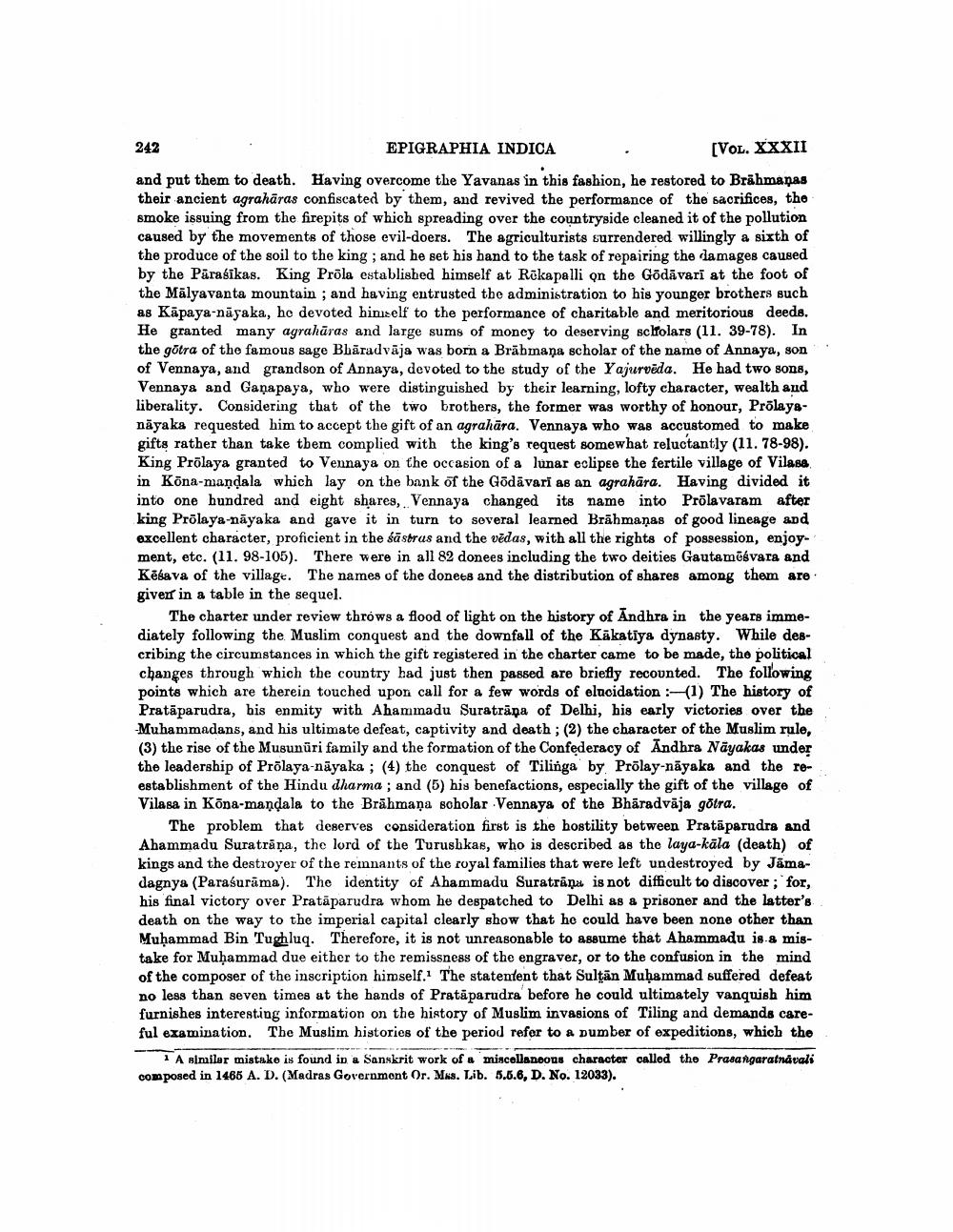________________
242
EPIGRAPHIA INDICA
[VOL. XXXII and put them to death. Having overcome the Yavanas in this fashion, he restored to Brahmanas their ancient agrahāras confiscated by them, and revived the performance of the sacrifices, the smoke issuing from the firepits of which spreading over the countryside cleaned it of the pollution caused by the movements of those evil-doers. The agriculturists surrendered willingly a sixth of the produce of the soil to the king; and he set his hand to the task of repairing the damages caused by the Parasikas. King Prōla established himself at Rekapalli on the Godavari at the foot of the Malyavanta mountain; and having entrusted the administration to his younger brothers such as Kāpaya-nayaka, he devoted himself to the performance of charitable and meritorious deeds. He granted many agrahāras and large sums of money to deserving sclfolars (11. 39-78). In the gōtra of the famous sage Bharadvaja was born a Brahmana scholar of the name of Annaya, son of Vennaya, and grandson of Annaya, devoted to the study of the Yajurvēda. He had two sons, Vennaya and Ganapaya, who were distinguished by their learning, lofty character, wealth and liberality. Considering that of the two brothers, the former was worthy of honour, Prōlayanayaka requested him to accept the gift of an agrahara. Vennaya who was accustomed to make gifts rather than take them complied with the king's request somewhat reluctantly (11.78-98). King Prōlaya granted to Vennaya on the occasion of a lunar eclipse the fertile village of Vilass in Kōna-manḍala which lay on the bank of the Godavari as an agrahāra. Having divided it into one hundred and eight shares, Vennaya changed its name into Prōlavaram after king Prōlaya-nayaka and gave it in turn to several learned Brāhmaṇas of good lineage and excellent character, proficient in the sastras and the vedas, with all the rights of possession, enjoyment, etc. (11. 98-105). There were in all 82 donees including the two deities Gautamēśvara and Kesava of the village. The names of the donees and the distribution of shares among them are giver in a table in the sequel.
The charter under review throws a flood of light on the history of Andhra in the years immediately following the Muslim conquest and the downfall of the Kakatiya dynasty. While describing the circumstances in which the gift registered in the charter came to be made, the political changes through which the country had just then passed are briefly recounted. The following points which are therein touched upon call for a few words of elucidation :-(1) The history of Prataparudra, bis enmity with Ahammadu Suratrapa of Delhi, his early victories over the -Muhammadans, and his ultimate defeat, captivity and death; (2) the character of the Muslim rule, (3) the rise of the Musunuri family and the formation of the Confederacy of Andhra Nayakas under the leadership of Prōlaya-nayaka; (4) the conquest of Tilinga by Prōlay-nayaka and the reestablishment of the Hindu dharma; and (5) his benefactions, especially the gift of the village of Vilasa in Kōna-mandala to the Brahmana scholar Vennaya of the Bharadvāja gōtra.
The problem that deserves consideration first is the hostility between Prataparudra and Ahammadu Suratrana, the lord of the Turushkas, who is described as the laya-kala (death) of kings and the destroyer of the remnants of the royal families that were left undestroyed by Jamadagnya (Parasurama). The identity of Ahammadu Suratrana is not difficult to discover; for, his final victory over Prataparudra whom he despatched to Delhi as a prisoner and the latter's death on the way to the imperial capital clearly show that he could have been none other than Muḥammad Bin Tughluq. Therefore, it is not unreasonable to assume that Ahammadu is a mistake for Muḥammad due either to the remissness of the engraver, or to the confusion in the mind of the composer of the inscription himself. The statement that Sultan Muhammad suffered defeat no less than seven times at the hands of Prataparudra before he could ultimately vanquish him furnishes interesting information on the history of Muslim invasions of Tiling and demands careful examination. The Muslim histories of the period refer to a number of expeditions, which the
A similar mistake is found in a Sanskrit work of a miscellaneous character called the Prasangaratnavali composed in 1465 A. D. (Madras Government Or. Mas. Lib. 5.5.6, D. No. 12033).




